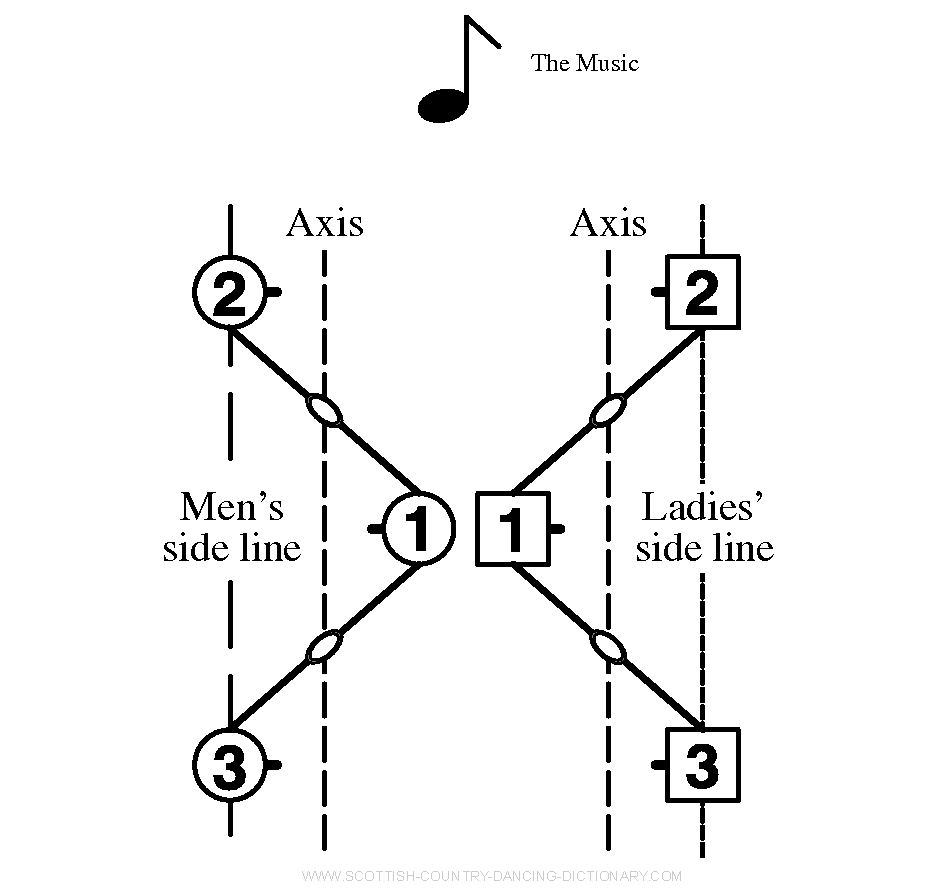Double Triangles In Scottish Country Dancing
Double triangles is logically an 8-bar derivative form of Balance in line found in Longwise, Active sets with 3 Couples though, historically, it is probably the precursor; it requires four complete Pas-de-basque Setting steps.
Double Triangles
Bars 1-2
the Dancing couple, in 2nd Place, Starting Back-to-back in the Centre of The set and Facing Out on Own sides (as shown in the diagram), Take Right hands with Partner's First corners and left with Partner's Second corners and all Set;
Bars 3-4
all drop hands and, While the Corners continue to Set, the Dancing couple, using Pas-de-basque, Dance around each other halfway clockwise, maintaining their Back-to-back relative Position;
Bars 5-6
the Dancing couple, Back-to-back but now Facing Out on Opposite Sides, Take Right hands with First corners and Left hands with Second corners and all Set;
Bars 7-8
all drop hands and, While the Corners continue to Set, the Dancing couple, using Pas-de-basque, Dance round each other halfway clockwise, maintaining their Back-to-back relative Position, Finishing in their Starting Positions.
It is polite to acknowledge the adjacent Dancers while Setting, making Eye contact with the Dancer to the right during the first bar of Pas-de-basque and with the Dancer to the left during the second.
This Scottish Country Dancing Figure is supposed to represent a St Andrew's Cross as seen from above and so, even more than in other Balancing Figures, the arms should be extended as fully as is practicable; the Dancing couple should be almost touching Back-to-back and so, if the Dancers' arms are not long enough, the Corners must Advance slightly to Take hands. The diagram shows the Position of the Dancers during the first two bars of the Figure as in bars 9-10 of The Hunting Horn. When the axis of the Figure is defined as the line joining the joined hands (as in Balance in line), this axis is parallel to, but not exactly the same as, the Side lines since the Corners again do not move Outward from their Standing places.
As with all Balancing Figures, Double triangles cannot be performed using the Strathspey setting step because this would involve sideways movement with alternate Dancers going in opposite directions.
Note that in some dances, for example, The Whistling Wind and The Starry Eyed Lassie, Flow between figures requires the formal version of Double triangles as described above to Finish slightly differently in order to suit the succeeding Figure; the Dancing couple must adapt the movement in bars 7-8, though still using Pas-de-basque.
In one alternative form, the Dancing couple Start Facing their Opposite Sides; in another, they Start Facing Up and down.
A derivative form exists for 5 Couples with two Dancing couples, one in 2nd Place, the other in 4th; the Dancers in 3rd Place are First corners for one Dancing couple and Second corners for the other as in bars 33-40 of Linkumdoddie.
Inverted double triangles is a more complex derivative form as, for example, in bars 9-16 of The Nurseryman. All Balance in line normally at first and then all Set advancing, Turning on the spot halfway; next they Balance in line in the inverted form with the Dancing couple Facing In and Corners Facing Out; finally, all Set advancing, Finishing as required for the succeeding Figure.
Here are examples of those Scottish Country Dances for which we have instructions on this site and in which the term, Double triangles, either appears explicitly or is implied; note that for a common term these will be a small selection; for a rare term, these may be all that exist:
Connie's Jig
Lochnagar
Mary Erskine
Reids O' Monymusk
Dance Video Clip Which Demonstrates Double Triangles
Double Triangles Video ClipDance Video Clip Which Demonstrates Inverted Double Triangles
Inverted Double Triangles Video ClipLinks To Pages Related To 'Setting'
FiguresBalance (In Line)
Crown Triangles
Double Hello-Goodbye Setting
Double Triangles
Hello-Goodbye Poussette
Hello-Goodbye Setting
Inverted Double Triangles
Set
Set Advancing
Set Advancing And Retire
Set In Line
Set On The Side (Line)s
Set To First Corners
Set To Second Corners
Set Twice
Set Up And Down
Turn On The Spot
Back to the top of this Scottish Country Dancing 'Double Triangles' page